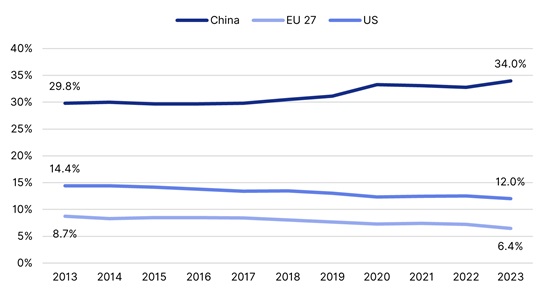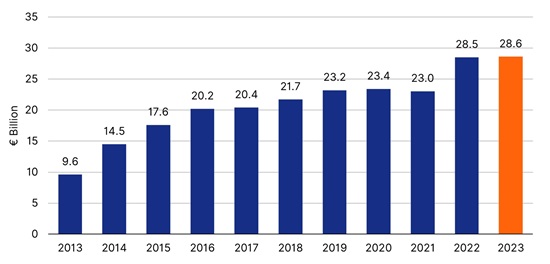Announcements
Drinks

COP29: EU, China hold the key to making good on latest climate-change commitments
By Stefan Ritzka, ESG Analysis
With Donald Trump elected to succeed Joe Biden as US president, a new degree of uncertainty is hanging over American environmental policy with the possibility that the US will confirm its withdrawal from the Paris Agreement by 2026. That leaves climate finance beholden to the net-zero ambitions of European countries and China's more strategic goals of reducing its reliance on oil and gas.
The previous agreement on New Collective Quantified Goal (NCQG), adopted in 2015, provided a framework for future climate finance targets. Under this framework, the initial target of USD 100bn a year by 2020 was reached in 2022.
Since then, the inexorable rise in global greenhouse gas emissions and energy demand has led to the conclusion that this amount is far from sufficient, hence the agreement at COP29 to triple financing to developing countries, from the previous goal of USD 100bn annually, to USD 300bn annually by 2035.
This relatively modest target given an initial proposal of agreeing to USD 1.3 trn underscores the need for sustained financial commitments from the public and private sector to further encourage renewable-energy projects, climate-adaptation strategies and CO2-emissions reduction in more vulnerable, poorer countries.
Figure 1: Annual CO₂ emissions from the world’s largest economies (% of total)

Source: European Commission - Emissions Database for Global Atmospheric Research (EDGAR)
China leads US and EU in terms of CO2 emissions
In terms of annual CO2 emissions by country, the US, home to the world’s largest economy, contributed an estimated 12% of the total emissions in 2023 – nearly twice as much as the EU. However, when it comes to climate finance, the US contributions in 2022 amounted to a lower-than-expected USD 5.8bn. With the shift in energy and environmental policies under Trump, and likely retreat from climate commitments, the focus for CO2 mitigation and climate finance in the coming years will fall on the shoulders of others.
China, the world´s second-largest economy, is the top CO2 emitter accounting for around 34% globally in 2023. By being classified as a developing country by the United Nations, they are not obligated under Art. 9 of the Paris Agreement to provide financial support. However, with their emissions seemingly only recently achieved its peak, China will need to intensify its efforts towards industrial decarbonisation and implement a more sustainable clean- power policy if any decrease in world emissions is to take place.
The third largest economy – the European Union – in contrast emitted relatively little CO2 at around 6% at year-end 2023, implying its contribution may be rather to scale up the funding of international emissions-reductions efforts and climate change mitigation. The estimated EU contribution of EUR 28 billion in 2023 towards climate finance, in line with that provided the year before, points to the gap between available funding and the scale of the task identified at COP29.
Figure 2: Europe’s contribution to climate finance

Source: Council of the European Union
Can the EU leverage more of economic heft for climate financing?
The EU has the possibility of leveraging more of its economic power to promote green transition projects and provide climate related funding towards developing countries but, in the context of the other demands on European public finances – domestic infrastructure, health and welfare spending, defence – it is far from clear how much more European countries can contribute.
Many low- and middle-income countries were disappointed that commitments at COP29 fell so far short of the initial target.
However, initiatives such as Italy’s recently announced EUR 4bn fund, which is mostly aimed at developing sustainable infrastructure and energy cooperation in northern Africa, may serve as an example of how to address domestic and international economic, environmental and social issues at the same time.






